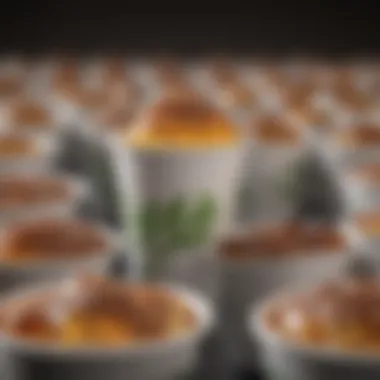Simply Modern Cups: Exploring Design and Culture


Intro
Modern cups represent more than just receptacles for beverages; they embody a blend of aesthetic appeal, functionality, and cultural significance. The evolution of cup design reflects changing consumer preferences and values, particularly in today's world where issues like sustainability and style are at the forefront. This article unveils the journey of simply modern cups, exploring their varied designs, materials used in their construction, their environmental impact, and their role in contemporary culture.
Cups serve as a focal point in dining experiences, with their shapes and materials influencing both taste and presentation. In an era where consumers are more conscious about their choices, the rise of eco-friendly options in cup manufacturing is noteworthy. This exploration seeks to dive deep into the trends shaping the modern cup, particularly for those who appreciate elegance and practical design.
As we proceed, several key topics will be addressed:
- The historical perspective on cup design and notable changes.
- The materials that define today's cups, including sustainable choices.
- Cultural influences that shift consumer preferences.
- The integration of traditional craftsmanship with modern techniques.
By framing our discussion around the interplay of design, cultural insights, and sustainability, we aim to provide a thorough overview of simply modern cups.
Preface to Simply Modern Cups
The concept of simply modern cups transcends mere utility in the realm of dining and beverage consumption. These cups encapsulate a blend of aesthetics and functionality, making them critical in today's consumer landscape. Understanding simply modern cups involves exploring their design, materials, and cultural relevance. As more individuals become discerning about their choices, the significance of these cups continues to rise.
Definition and Characteristics
Simply modern cups are characterized by their clean lines and understated elegance. They focus on minimalism without compromising on functionality. One key feature is the emphasis on usability. Many of these cups are designed to fit comfortably in one’s hand, with shapes that enhance the drinking experience. Common materials include ceramics, glass, and stainless steel, chosen for both their durability and aesthetic appeal.
Also, this style often aligns with sustainable practices. Consumers are now mindful of the environmental impact of their purchases, which influences design elements as well. Eco-friendly materials like bamboo and bioplastics are gaining traction. Overall, the primary goal of simply modern cups is to enhance the experience of enjoying beverages while making a statement about style and sustainability.
Historical Context
The evolution of cup design mirrors shifts in societal needs and preferences. Historically, cups have served basic functions, transitioning from rudimentary vessels to intricate works of art. In the past, ceramics were predominant, reflecting local cultures and traditions. As the Industrial Revolution progressed, mass production allowed for uniform designs, leading to an era where form often overshadowed function.
The late 20th century saw a resurgence of interest in craftsmanship and artisanal design. This period laid the groundwork for the modern cups we see today, merging traditional techniques with contemporary aesthetics. Today, simpler forms reflect a fast-paced lifestyle, as consumers prioritize ease of use alongside visual appeal. As societies evolve, so do cups, adapting to meet changing demands for both style and sustainability.
"The design of cups is not only about aesthetics; it reflects cultural changes and consumer needs over time."
In summary, understanding simply modern cups offers insights into not only individual preferences but also broader social trends. The blend of practicality, sustainability, and design excellence positions these cups as an essential aspect of modern dining experiences.
Design Innovations
Design innovations play a crucial role in understanding simply modern cups. They encapsulate not only the aesthetic and functional capabilities of cups today, but also how these elements cater to evolving consumer needs. The importance of design innovations lies in their ability to blend simplicity with functionality. Consumers are often drawn to designs that enhance their experience without overwhelming their senses. In a world where individuals seek efficiency, clever design solutions do much more than just look good. They create a balance between form and purpose, allowing users to enjoy their beverages fully.
Minimalistic Aesthetics
Minimalistic aesthetics emphasize clean lines and uncluttered forms. This trend in cup design strips away excess decoration, thus focusing on the essence of the object. Such design allows the cup to complement its surroundings, making it more versatile for various settings. In a consumer market that increasingly values simplicity, cups featuring minimalistic aesthetics are often more visually appealing. They provide a space for mindfulness, as users engage with the object itself. A minimalist cup can resonate with environmental consciousness, suggesting a lesser impact on resources. This aesthetic aligns well with current lifestyle trends, making it a popular choice for many consumers.
Functional Features
The functional aspects of modern cups are vital in enhancing user experience. Three main functional features have gained prominence in recent designs: ergonomic designs, temperature retention, and stackability.
Ergonomic Designs
Ergonomic designs focus on comfort and practicality. They are crafted to fit naturally within the hand, making it easier to hold and use. This characteristic is particularly beneficial for those who use cups frequently, such as coffee lovers or tea drinkers. One unique feature of ergonomic designs is the slight contour or curvature that allows for a more secure grip. This design not only enhances comfort but also reduces the risk of spills. However, some might argue that ergonomic designs can sometimes overlook aesthetic appeal. Nevertheless, the balance of form and function makes ergonomic cups a favorable choice in modern consumption.
Temperature Retention
Temperature retention is another critical functional feature. Many consumers prefer cups that keep beverages hot or cold for extended periods. The primary focus here is on the insulating materials used. Cups with double-walled construction are an example, as they provide effective insulation while remaining comfortable to hold. This feature makes them an excellent choice for those who enjoy their drinks at precise temperatures. While temperature retention is advantageous, it can increase the cost of production. However, for those who appreciate a consistent drinking experience, the benefits clearly outweigh the disadvantages.


Stackability
Stackability addresses practical storage solutions. Cups designed to nest within one another can save space, a key consideration in many households. The highlight of stackable cups is their ability to maintain a tidy and organized cupboard or shelf. This feature is particularly appealing to urban consumers with limited storage space. However, some designs may compromise stability or functionality for the sake of simplicity. Yet, in the realm of modern cups, stackability continues to be a sought-after trait.
In summary, design innovations greatly enhance the utility and appeal of simply modern cups. This blend of aesthetic simplicity with functional excellence caters to sophisticated consumer preferences.
Materials Used in Modern Cups
Understanding the materials used in modern cups is crucial to grasping their design and functionality. Choices of materials influence not just the aesthetic appeal but also the durability, safety, and sustainability of the cups we use daily. Different materials bring forth unique characteristics and benefits, affecting consumer preferences and environmental impacts.
Ceramics and Porcelain
Ceramics and porcelain are revered for their classic appeal and structural integrity. Porcelain is a type of ceramic that contains a higher percentage of kaolin and is fired at a higher temperature, making it more durable and less porous. This material is excellent for maintaining the temperature of beverages, which enhances the drinking experience. Its smooth surface and ability to be intricately designed contribute to its popularity among consumers who seek beauty alongside functionality. However, it can be heavy and prone to chipping under certain conditions.
Glass and Crystal
Glass has a timeless charm that appeals to many consumers. It allows the vibrant colors of beverages to shine through, adding to the visual experience of drink consumption. Crystal, a type of glass that contains lead or other metal oxides, offers superior clarity and brilliance. While it is aesthetically appealing, crystal can be less practical due to its fragility. Both glass and crystal are recyclable materials, aligning with the growing interest in environmental concerns among consumers.
Metallic Options
Metal cups, particularly those made from stainless steel, copper, and aluminum, have gained traction due to their durability and unique design properties.
Stainless Steel
Stainless steel is known for its resistance to rust, corrosion, and staining, making it a popular choice in the manufacturing of modern cups. Its strength contributes to its longevity, allowing manufacturers to create sleek and minimalist designs. Unlike some plastic options, stainless steel is not linked to any harmful chemical leaching, thus ensuring the purity of beverages. Additionally, stainless steel cups often maintain beverage temperature for longer, which is a sought-after feature in today’s fast-paced lifestyle. However, they can be heavier than their plastic counterparts, which may be a consideration for some users.
Copper and Aluminum
Copper and aluminum are lightweight materials often used for specific types of cups. Copper cups, particularly, are popular for serving cocktails, such as the Moscow Mule. They provide a unique aesthetic and maintain the coolness of the drink, enhancing flavor. However, copper can react with acidic beverages, which is why it is often lined with stainless steel.
Aluminum, on the other hand, is versatile and lightweight, making it a preferred choice for outdoor cups and travel mugs. Its recyclability adds to its appeal, crafting a more sustainable option. Yet, aluminum is typically not as durable as stainless steel and can bend or warp under strain. Both materials have unique features that cater to diverse consumer needs and preferences.
Sustainable Materials
With rising environmental awareness, the demand for sustainable materials in the production of cups has surged in recent years.
Bamboo and Bioplastics
Bamboo, a fast-growing natural resource, is gaining recognition in the cup manufacturing sector. It offers a renewable alternative to traditional materials, appealing to consumers looking for eco-friendly choices. Bioplastics, derived from renewable sources such as corn starch, provide a similar sustainable alternative. Both bamboo and bioplastics reduce plastic waste and lower carbon footprints. However, these materials may not consistently offer the same durability as glass or metals.
Recycled Materials
The use of recycled materials in cup production provides an innovative way to tackle environmental concerns. By repurposing plastics and other materials, manufacturers contribute to waste reduction while offering a variety of stylish options. Cups made from recycled materials often possess unique characteristics, making them desirable for eco-conscious consumers. However, quality can vary based on the recycling process and the initial materials used.
Cultural Significance of Cups
The cultural relevance of cups cannot be overstated. Cups are not just functional items; they carry meanings and practices that are deeply rooted in various societies. Their significance extends beyond their practical use to the realms of social interaction, tradition, and emotion. In examining the cultural significance of cups, one can understand how they bridge everyday practices with deeper social contexts.
Cups in Everyday Life
Cups play a vital role in daily routines across the globe. They are central to moments of connection, whether at home, in cafes, or at social gatherings. The act of sipping from a cup can provoke a sense of community. The specific materials and designs also influence how people engage with their drinks and, by extension, with each other.
In many cultures, sharing a drink from a cup is a form of hospitality. It invites others to pause and engage in conversation. The presence of a cup can make a setting feel warm and welcoming. For instance, a ceramic tea cup might evoke a more intimate atmosphere than a metal mug. This can be important for social cohesion.


Symbolism and Rituals
Cups are often embedded in various rituals, imbuing them with significant meanings. Their usage tends to symbolize hospitality, comfort, and sometimes, lavishness. For example, the simple act of offering a cup of tea can signify care and attention in many cultures.
Tea and Coffee Ceremonies
Tea and coffee ceremonies are significant cultural practices in which cups serve as central elements. These ceremonies are not just about the beverages; they represent tradition and social values. The process of preparing and consuming these drinks becomes an art form, emphasizing patience and presence.
One of the most characteristic aspects of tea ceremonies is the mindfulness involved. This unique feature encourages participants to slow down and appreciate the moment. It is a beneficial choice in our fast-paced world, promoting mental well-being and social bonds.
However, not every person may connect with the formality of these ceremonies, which can seem intimidating. Still, their advantages often compel individuals to engage with these traditions, as they foster rich conversations and a sense of belonging.
Celebratory Drinks
Celebratory drinks often elevate social gatherings, and cups serve as symbols of these joyous occasions. Whether it is a toast at a wedding or a simple gathering with friends, the cup becomes a vessel for happiness and connection. The act of clinking glasses or raising a cup signifies more than just beverage consumption; it is a ritual of solidarity and celebration.
The key characteristic of celebratory drinks is their role in marking significant moments. These drinks encourage people to come together and share experiences. However, they may also lead to excess or unplanned indulgences, which can be seen as a disadvantage. Nevertheless, the essence of celebration often outweighs potential drawbacks, making them an integral part of cultural practices.
Cups have become symbols of connection and festivity that enrich our social experiences.
Consumer Trends and Preferences
The consumer trends and preferences surrounding simply modern cups play a crucial role in shaping the direction of the market. Understanding these patterns informs manufacturers about what consumers desire, allowing them to design products that meet contemporary needs. This section explores two key areas: aesthetics versus functionality, and the rise of personalization.
Aesthetics vs. Functionality
In the realm of simply modern cups, aesthetics and functionality often stand in a precarious balance. Consumers today are not only looking for something that serves its purpose but also something that pleases the eye. While the function of a cup, such as its capacity to hold liquids, remains paramount, many consumers find themselves increasingly drawn to unique designs and forms.
- Visual Appeal: The appeal of materials, colors, and shapes influences consumer choices. For example, matte finishes, organic shapes, and innovative graphic designs are trending.
- Practical Considerations: On the other hand, a cup must also serve its intended function effectively.
- Heat Retention: Materials that retain heat or coolness become a priority.
- Ergonomics: Comfort during use is crucial for repeated purchases.
Consumers often weigh these two factors before making a decision. A cup must strike a good balance to stand out in the fast-paced market. It is evident that individuals are willing to invest in cups that not only serve beverages but also enhance their dining experiences.
The Rise of Personalization
Another significant trend is the rise of personalization in simply modern cups. As consumers seek to express their identity and preferences, the demand for personalized items has grown substantially. This is seen in several ways:
- Custom Designs: Brands now allow consumers to customize their cups with names, colors, and unique designs. This personal touch helps consumers feel more connected to the product.
- Cultural Significance: Personalization goes beyond aesthetics. It reflects the cultural values and individual stories of consumers. Many prefer cups that tell their stories or signify a meaningful moment in their lives.
- E-commerce Influence: Online markets facilitate this trend with platforms that let consumers easily create bespoke designs.
"Personalization transcends mere aesthetics; it embraces the essence of individual expression in everyday objects."
Ultimately, understanding these trends allows for a holistic view of the current landscape of simply modern cups. Recognizing consumer preferences not only benefits manufacturers but also enhances the overall consumer experience.
Environmental Impact of Cup Production
The environmental impact of cup production is a crucial consideration in today’s context of increased awareness about sustainability and ecological responsibility. Unlike ancient times, present-day consumers are guided not just by aesthetics and functionality but also by the ecological footprint of the products they choose. This section focuses on the significant effects that cup manufacturing has on our planet and outlines how sustainability plays a vital role in modern consumption.
There are several dimensions to contemplate: resource extraction, production processes, transportation, and lifecycle management. Each of these components contributes to environmental degradation if not managed properly. Understanding how different materials and methods affect the environment allows consumers to make informed choices.
Sustainable Practices


Sustainable practices in cup production are essential for minimizing environmental impact. These practices can take many forms, encompassing everything from the sourcing of materials to energy use in manufacturing. Here, we will explore key elements of sustainable production:
- Material Sourcing: Using renewable or recycled materials reduces reliance on virgin resources. Companies increasingly turn to bamboo, bioplastics, and recycled metals in their production.
- Energy Efficiency: Many manufacturers are investing in energy-efficient technologies. This includes using renewable energy sources, such as solar or wind power, to minimize carbon emissions during production.
- Water Conservation: Water usage in cup production can be significant. Implementing water-saving technologies can lessen the strain on local water supplies and reduce overall environmental impact.
Sustainable practices not only benefit the environment but also appeal to eco-conscious consumers. Companies that embrace these methods are often viewed as responsible, enhancing their brand reputation.
Waste Management and Recycling
Waste management and recycling are integral to reducing the environmental impact associated with cup production. By prioritizing waste reduction strategies, manufacturers can lessen their ecological footprint. Let's highlight some important aspects:
- Recycling Initiatives: Many modern cups are designed with recycling in mind. By creating cups from recyclable materials, producers help ensure that these items won’t end up in landfills.
- Consumer Education: Encouraging customers to return or recycle cups properly plays a significant role too. Clear labeling and information on recycling processes can enhance consumer participation.
- Closed-Loop Systems: Some companies adopt closed-loop systems where materials from used products are reprocessed into new products. This circular economy approach minimizes waste and maximizes resource use.
"In a world where natural resources are finite, recycling and sustainable practices are not just optional; they are imperative for future generations."
Emerging Trends in Cup Designs
Emerging trends in cup designs signify a shift in consumer preferences and technological advancements. These trends are critical to understanding how modern cups evolve to meet the demands of functionality, aesthetics, and sustainability. In this section, we explore both technological innovations and artisanal approaches that bring new dimensions to cup design.
Technological Integration
Smart Cups
Smart cups represent a fascinating juncture between beverage enjoyment and technology. One key characteristic of smart cups is their ability to integrate connectivity with mobile apps. This feature allows users to track the temperature of their drink, receive reminders for hydration, or even track caffeine intake. Such conveniences make smart cups a popular choice for health-conscious individuals.
A unique feature of smart cups is their temperature control capabilities. Many models allow the user to set and keep their preferred drinking temperature for longer periods. The advantage of this technology is significant; it enhances the drinking experience by keeping beverages at optimal temperatures.
However, there are disadvantages to consider as well. Smart cups tend to be more expensive than traditional options. They also require regular charging, which may be inconvenient for some users. Despite these concerns, their innovative design addresses a modern need that aligns with tech-savvy consumer preferences.
Temperature-Sensing Features
Temperature-sensing features in cups add another layer of innovation to the modern drinking experience. These functionalities allow cups to change color based on the temperature of the liquid inside. This characteristic provides an engaging visual cue, indicating when a beverage is ready to drink or too hot to touch.
The benefit of temperature-sensing features is that they enhance safety and enjoyment. Users can avoid the discomfort of burning their lips while enjoying hot drinks. Furthermore, this technology appeals to a demographic that values functional aesthetics.
Nonetheless, as with other technological integrations, some drawbacks exist. These cups can be more fragile due to the electronic components involved, and their market price may deter some consumers. Nonetheless, the rise of this technology reflects observable consumer trends seeking convenience alongside functionality.
Artisanal and Handmade Options
On the opposite side of the technological spectrum lies the resurgence of artisanal and handmade cups. This trend has gained popularity as consumers increasingly prioritize unique, handcrafted items. Artisanal cups often showcase intricate designs and individual craftsmanship that mass production cannot replicate.
These cups resonate with consumers who value the story behind an item, as well as its aesthetic. Buying handmade options supports local artisans and sustainable practices, often using eco-friendly materials. For many, this connection to the creator adds cultural significance to the simple act of drinking.
Nevertheless, there are some challenges associated with artisanal cups. Generally, these items can be more expensive, and their durability may vary compared to mass-produced counterparts. Yet for those who appreciate the nuances of craftsmanship and are willing to invest, artisanal cups offer a distinctive addition to any collection.
The End and Future Perspectives
The topic of Conclusion and Future Perspectives is pivotal within this article because it encapsulates the insights gained from exploring simply modern cups. This section not only sums up the discussions surrounding design, materials, and cultural significance but it also positions this knowledge within the broader landscape of consumer preference and sustainability trends.
The Ongoing Evolution of Cup Design
The design of cups is continuously changing, influenced by technology, consumer demand, and environmental considerations. Each era marks its own distinct characteristics, reflecting societal shifts. Currently, we see a blend of innovation and tradition. Manufacturers are integrating smart technology, such as heat-sensitive materials, into designs aimed at improving user experience.
For example, cups that can indicate temperature through color changes are becoming popular. Functionality is no longer an afterthought; it plays a central role in modern design philosophies. As consumers are increasingly environmental-aware, the choice of materials is under scrutiny. Choices made in production directly affect sustainability and the overall carbon footprint of the product. As we look ahead, these trends suggest that designs focusing on eco-friendliness as well as user utility will dominate.
Final Thoughts on Simply Modern Cups
Simply modern cups illustrate an intriguing synthesis of form and function. Their evolution mirrors consumer desires for both aesthetic appeal and practicality. In a market saturated with options, the significance of craftsmanship and the storytelling behind each product cannot be overlooked. The choices consumers make reflect their values. Cups are not merely vessels; they are a reflection of identity and culture.
Through this exploration, it is clear that simply modern cups have much to offer. Their journey from utilitarian objects to design statements encapsulates broader trends in our society. As we move forward, the interplay of sustainability, personalization, and technology in cup design will define the next chapter in this fascinating narrative. Recognizing these shifts allows both consumers and manufacturers to embrace the future with informed perspectives.







